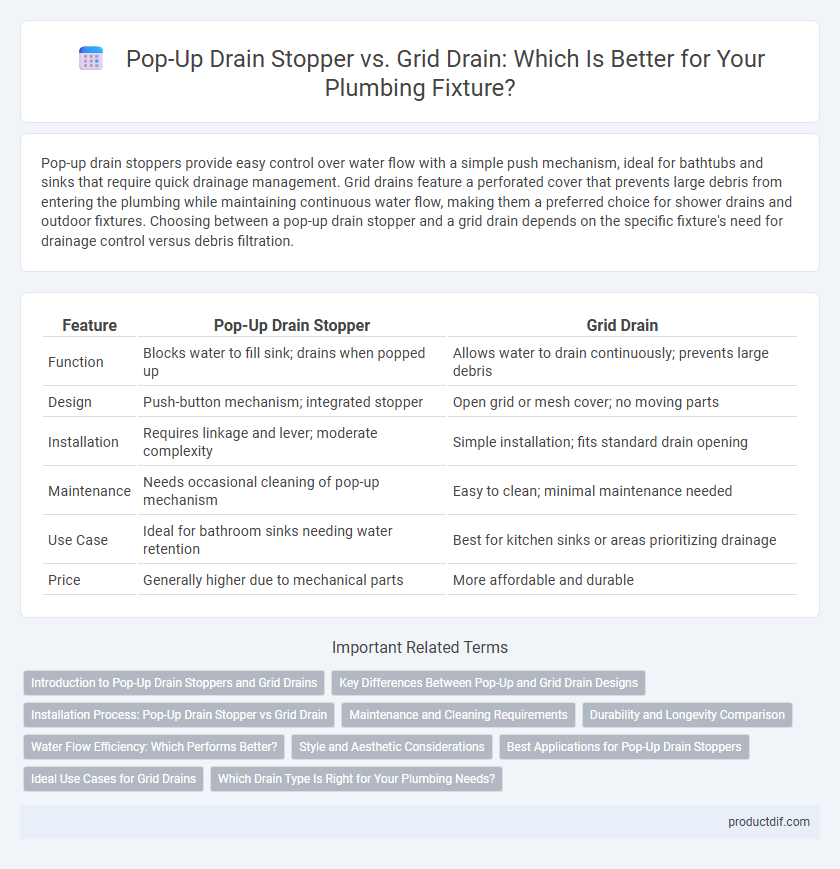Pop-up drain stoppers provide easy control over water flow with a simple push mechanism, ideal for bathtubs and sinks that require quick drainage management. Grid drains feature a perforated cover that prevents large debris from entering the plumbing while maintaining continuous water flow, making them a preferred choice for shower drains and outdoor fixtures. Choosing between a pop-up drain stopper and a grid drain depends on the specific fixture's need for drainage control versus debris filtration.
Table of Comparison
| Feature | Pop-Up Drain Stopper | Grid Drain |
|---|---|---|
| Function | Blocks water to fill sink; drains when popped up | Allows water to drain continuously; prevents large debris |
| Design | Push-button mechanism; integrated stopper | Open grid or mesh cover; no moving parts |
| Installation | Requires linkage and lever; moderate complexity | Simple installation; fits standard drain opening |
| Maintenance | Needs occasional cleaning of pop-up mechanism | Easy to clean; minimal maintenance needed |
| Use Case | Ideal for bathroom sinks needing water retention | Best for kitchen sinks or areas prioritizing drainage |
| Price | Generally higher due to mechanical parts | More affordable and durable |
Introduction to Pop-Up Drain Stoppers and Grid Drains
Pop-up drain stoppers offer a convenient mechanism operated by a lever or push button, allowing users to easily open or close the drain for water retention or release in sinks and bathtubs. Grid drains feature a fixed metal grate that prevents large debris from entering the plumbing system while allowing continuous water flow, making them ideal for kitchen sinks and outdoor installations. Both alternatives enhance functionality and maintenance, catering to different drainage needs and aesthetic preferences.
Key Differences Between Pop-Up and Grid Drain Designs
Pop-up drain stoppers feature a lever-activated mechanism that allows users to easily open or close the drain, providing a watertight seal for bathtubs and sinks. Grid drains consist of a fixed metal grate or cover with small openings, designed to prevent debris from entering the drain while allowing water to flow freely. The primary distinction lies in functionality: pop-up drains offer adjustable closure for water retention, whereas grid drains provide continuous drainage without the ability to stop water flow.
Installation Process: Pop-Up Drain Stopper vs Grid Drain
The installation process of a pop-up drain stopper involves mounting a drain flange, connecting the stopper mechanism to the lift rod, and securing the pivot rod to ensure smooth operation. In contrast, a grid drain requires simply fitting the grate into the drain opening and sealing it with plumber's putty or silicone without any moving parts. Pop-up drains are generally more complex and time-consuming to install compared to the straightforward setup of grid drains.
Maintenance and Cleaning Requirements
Pop-up drain stoppers require regular cleaning to remove hair and debris trapped in the pivot rod and stopper mechanism, which can clog the drain and reduce functionality. Grid drains, featuring a perforated grate design, minimize debris buildup by allowing water to flow through while blocking larger particles, making them easier to maintain with occasional surface cleaning. Both systems benefit from routine inspection and cleaning, but grid drains typically demand less frequent maintenance due to their simpler design and lack of moving parts.
Durability and Longevity Comparison
Pop-up drain stoppers typically feature robust metal or high-grade plastic components designed for repeated use, offering enhanced durability in residential bathroom sinks. Grid drains, often made from stainless steel mesh, excel in preventing debris but may be more susceptible to corrosion over time, affecting longevity. Selecting a pop-up drain stopper generally ensures a longer-lasting drainage solution with fewer maintenance issues compared to grid drains.
Water Flow Efficiency: Which Performs Better?
Pop-up drain stoppers provide adjustable water flow control by allowing the sink to fill or drain as needed, but they may restrict water flow when partially closed, potentially leading to slower drainage. Grid drains maximize water flow efficiency through their open design, preventing debris from entering the plumbing while enabling continuous drainage without obstruction. For applications prioritizing rapid water evacuation and minimal clogging, grid drains generally outperform pop-up stoppers in water flow efficiency.
Style and Aesthetic Considerations
Pop-up drain stoppers offer a sleek, modern look with a clean, minimalistic design that seamlessly blends into contemporary bathroom fixtures, enhancing the overall aesthetic appeal. Grid drains feature a more traditional, decorative style with a perforated top that adds texture and visual interest, often complementing vintage or industrial-themed spaces. The choice between pop-up and grid drains significantly influences the bathroom's style, where pop-ups emphasize smooth surfaces and grids provide intricate detailing.
Best Applications for Pop-Up Drain Stoppers
Pop-up drain stoppers are best suited for bathroom sinks and vanity basins where water retention and controlled drainage are essential. Their easy-to-operate mechanism allows users to seal the basin for activities like face washing or shaving, preventing water from draining out. This type of stopper is ideal for residential settings prioritizing convenience and a sleek, integrated appearance.
Ideal Use Cases for Grid Drains
Grid drains are ideal for bathroom sinks that require efficient water drainage without risking clogs from larger debris. Their open design prevents accumulation of hair and soap, making them suitable for high-traffic areas like public restrooms or family bathrooms. Grid drains also complement modern and minimalist sink styles, providing both functionality and aesthetic appeal.
Which Drain Type Is Right for Your Plumbing Needs?
Pop-Up drain stoppers offer a sleek, convenient solution for sinks requiring easy control of water flow, ideal for bathroom basins where water retention is often desired. Grid drains, featuring a perforated cover, allow continuous drainage, making them suitable for kitchen or utility sinks where debris blocking is a concern. Choosing the right drain depends on whether you prioritize water retention and ease of use or consistent drainage and debris filtering in your plumbing setup.
Pop-Up Drain Stopper vs Grid Drain Infographic

 productdif.com
productdif.com